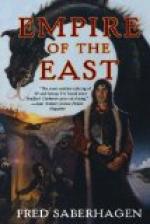“Will he never regain his freedom?” we asked.
A shrug of the shoulders was all that our guide vouchsafed, and with that awful voice ringing in our ears we were glad to turn away.
Two mosques still exist, and are in use, for the Turkish population is fairly large, though owing to recent events rapidly diminishing, but the Prince does everything in his power to cultivate a friendly feeling with the Mahometans. His country is the asylum for the persecuted Turk as well as the fugitive from justice, and, if his crime is political, he will be warmly welcomed.
But, Woman again has upset the best of intentions, and within a year four elopements of Turkish girls from their homes with Montenegrins have taken place in Podgorica. These girls have been baptised and married to their Christian lovers. A worse insult to the Mahometan faith does not exist. But of this more anon.
The modern town is painfully plain and uninteresting. Montenegrins have no knowledge or love of architecture. Each house is built solidly of stone, square and undecorated. Even the palaces of the Royal Family are of puritanical simplicity externally.
There are the law courts, post and telegraph offices, and police-station all in one, a school, and a market-place, with a very ugly memorial to the fallen Montenegrins in the last war. Otherwise, the town is laid out with broad streets, all planted with trees, exactly like a South African township.
Building plots are free, the only obligation to the owner being that he must run up the outside walls of the house at once. The roof and internal work can be completed at leisure. A large part of the town consists of mere shells of houses, the owners waiting for the means of completion.
Some little distance from the town, across the Moraca, is the Prince’s palace of Krusevac, which he occasionally visits. It stands quite alone on a slight eminence.
The view round Podgorica is one of the most fascinating features of the place. It is one of those perfect views which never tire, and always present some new beauty, and the armed rough men in their brightly coloured and novel costumes are in complete unison with the picture. These national costumes seem so absolutely fitting to Montenegro that the otherwise plain and uninteresting buildings of the town are turned merely into a background for the ever-moving stream of colour. The Turkish bazaars with their gaudy wares hung out into the street, the red-jacketed Montenegrin, the Turk in pure white, the Scutarines in their distinct and original costume, and the Albanians who flock in hundreds to the market in coarse white serge, heavily bordered with black braiding, rifles over their shoulders and a bandolier round their waists, make a never-ending picture. We never wearied of wandering about the streets on market days. Then the town is filled to overflowing with a multi-coloured crowd, and every man from a distance brings his rifle.




